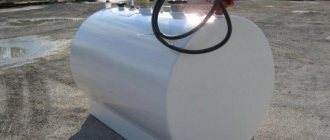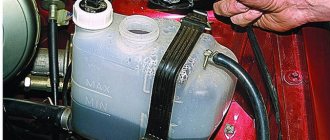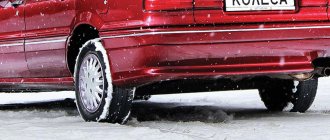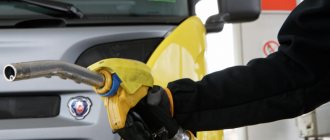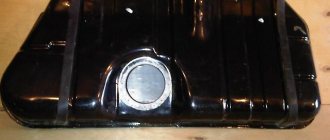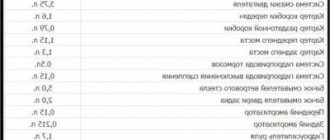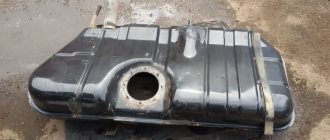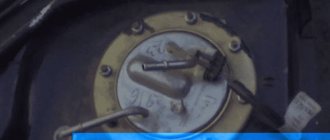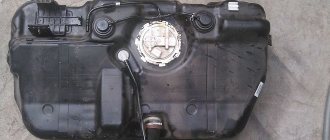How long can you drive on methane?
Table of advantages and disadvantages of propane and methane
| Factor | Propane | Methane |
| Consumption relative to gasoline (per 10 liters) | 11-11.5 liters | 8-8.5 cubes |
| Average tank weight | 20-30 kg | 60-125 kg |
| Fuel reserve for average set (kilometers) | 600-1000 km | 250-350 km |
| Explosive concentration in air | 2,1% | 4,4% |
Physical meaning of translation
In a physical sense, everything is quite simple. The translation is carried out in the same way for any gases, liquids or bulk materials as follows:
- 1 cubic meter contains 1000 liters,
- 1 liter equals 0.001 cubic meters
- the table shows the quantity contained in 1 cube (1 cube = 1000 cubic decimeters, etc.).
For example, 15 cubic meters of natural gas used by the meter equals 15,000 liters. When converting these values, the temperature of the fuel, the amount of impurities and other factors do not matter.
How many liters of gas are in a 50 liter cylinder?
In a household gas cylinder with a volume of 50 liters, according to current regulations, there should be no more than 85% of liquefied gas from the volume of the cylinder. 50 * 0.85 = 42.5 liters of gas. At the gas station you can be told the amount of gas to fill in both liters and kilograms.
Interesting materials:
How to add ink to an HP printer? How to fill a full tank of gasoline? How to Tin a ceramic soldering iron tip? How to cover up an inscription in Photoshop? How to slow down music in Sony Vegas Pro 13? How to replace Internet Explorer with Microsoft Edge? How to replace How are you? How to replace rights after expiration? How to replace expired rights in 2022? How to replace tomato paste with tomatoes?
Calculation example
It is necessary to determine how many cubic meters of gas one cylinder with a 50-liter propane-butane mixture contains if you pass its contents through a gas meter:
- the mass of the gas mixture pumped into it is about 21 kilograms;
- volume in m³ is equal to 50/5 = 10;
- after adjusting for the filling of the cylinder, we get 10 × 0.85 = 8.5 m³.
This indicator may vary depending on the ambient temperature, since when it decreases, the pressure inside the container decreases, with a corresponding decrease in the volume of fuel.
But the use of liters of gas in cubic meters is only relevant as an approximate calculation. When purchasing this type of fuel, kilograms of the gas mixture and the pressure inside the container are important, and when using individual metering devices, a standard unit of measurement is used - cubic meters, the conversion procedure of which does not depend on the composition of the gas and is determined by a simple arithmetic calculation in the ratio of 1 to 1000.
How many liters of methane are in a cube?
As people call it the “long-suffering” cubic meter – m3. Abbreviations such as cube and cubic meter are especially often used, universally accepted and understood by everyone. Our “people” do not change liters, their mentality does not allow it. The question of how many liters are in 1 cubic meter or one cube of methane may be of purely educational interest. Previously, this worried mainly schoolchildren and junior students solving problems in physics. However, today, people who are far from the school curriculum are beginning to remember long-forgotten information. Perhaps they want to check the accuracy of the calculations made on their own when converting liters to cubes, cubic meters or cubic meters - m3. Many drivers are accustomed to correlating fuel consumption and the mileage that a car can travel after refueling, based on the number of liters of gas filled into the cylinder. At gas stations, methane is counted in cubes. The task is quite simple, but often “complicated” by incorrect formulations of the question. Therefore, let's take a closer look.
Operating and Maintenance Costs
Well-regulated gas equipment requires virtually no maintenance, since neither liquefied nor main gas forms carbon deposits and soot. Preventive maintenance and control inspections are carried out regularly regardless of the type of fuel, and the costs are approximately the same.
Operating costs when using liquefied gas may include electricity costs if the system uses electrically heated evaporators. Evaporators are installed in powerful industrial systems to increase the rate of formation of the vapor phase, as well as with ground-based gas holders, since the natural evaporation of the butane component stops at subzero temperatures.
But electric evaporators are usually used in systems with relatively little gas consumption, and they do not consume as much energy. High-performance systems use liquid-heated evaporators, the heat for which is produced by burning the same liquefied gas.
So, the operating and maintenance costs for systems running on mainline and liquefied gas are almost the same.
Calculation results
Cost of installing gas equipment: Annual savings: Payback period: This is an investment of money at % per annum
a) Consumption coefficient of propane-butane (l) compared to gasoline (l) = 1.15; those. if gasoline consumption is 15 l/100 km, then propane consumption will be 17.25 l/100 km.
b) Methane consumption coefficient compared to gasoline = 0.9; those. with a gasoline consumption of 15 l/100 km, methane consumption will be 13.5 m3/100 km.
c) The volume of methane is measured not in liters, but in cubic meters. A 100 liter cylinder holds 25 m 3 of methane (100 l / 4 = 25 m 3).
How to convert cubes to liters? You will find out the answer to this question by reading this article.
The content of the article:
- How many liters are in 1 cubic liter?
- Formula for converting the volume of a cube into liters
- Formula for converting liters to cubic meters
- Examples of converting liters to cubes
- Examples of converting cubes to liters
How to convert cubes to liters?
Students often have difficulty converting one unit of measurement to another. Hence a lot of questions like:
- How many liters are in a cube?
- 1 cubic meter - how many liters is it?
- How many liters are in a cube of water?
- How many liters of gas, propane, gasoline, sand, earth, expanded clay are in a cube?
- How many liters of methane, liquefied gas are in a cube?
- How to convert cm cubed (cm 3) or dm cube (cm 3) to liters?
- A cube of concrete, gasoline, diesel fuel, diesel fuel - how many liters is that?
Next, we can identify a group of more specific questions, for example, how many liters are in a cube of water, and in a bath? Or how many cubes are in a barrel with a volume of 200 liters, and in a bucket, and in 10 liters? How many cubic meters is 40 liters of dry hydrogen? These questions are relevant both for students when solving various problems, and for practical purposes, for example, when buying some kind of water container. Let’s look into this issue thoroughly, remember, so to speak, the hardware, so that at any moment you can easily convert cubes into liters, and, of course, back.
How many liters are in 1 cubic liter?
Let us first pay attention to the fact that, regardless of the substance placed in the container, the conversion from liters to cubes will always be the same, be it water, gas, sand or gasoline.
Starting investments
The initial investment in an autonomous gasification system can be easily calculated based on the proposals of various companies. For example, installing an underground gas tank with a volume of 6.5 m3 on a turnkey basis in one day with all the necessary equipment will now cost from 400 to 500 thousand rubles. Such a gas holder is capable of supplying gas to an average house or cottage with a plot and household plot throughout the year, including gas consumption for heating and hot water supply.
With connection to the gas main, if gasification of houses or objects is not provided for in the master plan, everything is not so simple and unambiguous, and the proximity of the gas pipeline does not at all guarantee an easy solution to this problem. Firstly, connection may simply be impossible, since the capacity of gas pipelines is limited, and additional capacity may not be available.
How much does 1 liter of propane cost?
Cost of propane butane at gas stations. Current propane price: from 24.00 rubles per liter as of 06/23/2021. Depending on the volume and geography of delivery.
Interesting materials:
What doesn't cellulite love? What not to do during Palm Week? What should you not do before an ultrasound? What should not be done after the biorevitalization procedure? What should not be done in case of heat and sunstroke? What can't you eat on a diet? What cannot be sent to Canada by mail? What not to do before training? What is necessary to register land ownership? What to wear with a triangle figure?
Examples of converting liters to cubes
And now, armed with all the necessary knowledge, we can proceed directly to the calculations.
| Problem #1: How many liters are in 0.5 cubes? Solution: Using the above formula we get: 0.5 * 1000 = 500 liters. Answer: 0.5 cubes contain 500 liters. | Problem #6: How many liters are in 300 cubic meters? Solution: 300 * 1000 = 300,000 liters Answer: There are 300 thousand liters in 300 cubic meters. |
| Problem #2: How many liters are there in 1 cubic meter? (the simplest) Solution: 1 * 1,000 = 1,000 liters. Answer: 1 cube contains 1,000 liters. | Problem #7: 5 cubes - how many liters? Solution: 5 * 1000 = 5,000 liters Answer: 5 cubic meters is 5 thousand liters. |
| Problem #3: 2 cubes – how many liters? Solution: 2 * 1,000 = 2,000 liters. Answer: 2 cubes contain 2,000 liters. | Problem #8: 6 cubic meters is how many liters? Solution: 6 * 1000 = 6,000 liters. Answer: 6 cubes contain 6 thousand liters. |
| Problem #4: How many liters are in 10 cubes? Solution: 10 * 1000 = 10,000 liters Answer: 10 cubes contain 10 thousand liters. | Problem #9: How many liters are 4 cubes? Solution: 4 * 1000 = 4,000 liters Answer: 4 cubes contain 4 thousand liters. |
| Problem #5: 20 cubic meters is how many liters? Solution: 20 * 1000 = 20,000 liters Answer: 20 cubes contain 20 thousand liters. | Problem #10: How many liters are 500 cubic meters? Solution: 500 * 1000 = 500,000 liters Answer: There are 500 thousand liters in 500 cubic meters. |
Use of liquefied gas
It’s a little more complicated with liquefied gas. It is widely used:
- in modern industrial production;
- in thermal and electric power engineering;
- as a reserve stock during the period of the most intensive consumption by the population;
- as a replacement for traditional gasoline or diesel fuel for road transport;
- for domestic purposes.
In the household, it is advantageous to use liquefied gas in cylinders for the operation of gas-consuming household appliances, provided there is no centralized supply line.
Various mixtures of propane and butane are used for liquefaction. The use of methane is not economically profitable, since at room temperature the pressure in the system increases so much that to ensure safety it is necessary to create containers with large wall thicknesses and use materials of increased strength.
The change in gas volume during the transition from the liquid phase to the gaseous phase is determined by the following factors:
- chemical composition;
- pressure;
- temperature;
- density and specific gravity.
To calculate the number of liters of liquefied gas per cubic meters of fuel that have turned into a gaseous state, it is necessary to use the specified characteristics. But since it is difficult to reliably establish the exact composition of the mixture in the cylinder, it is necessary to be guided by an approximate ratio, according to which at a standard temperature of 20 degrees, 1 liter of liquefied gas will produce 200 - ordinary gas. Therefore the formula applies:
Okub = Ol/5
- Cube – volume in cubic meters;
- Ol – volume in liters.
When making calculations, it is necessary to additionally take into account that, for safety reasons, gas cylinders are filled to no more than 85 percent of the total volume.
Types of methane cylinders
Depending on the materials of manufacture, automobile containers for compressed natural gas (CNG) are divided into types:
Type 1 (KPG-1) - all-metal vessels made of alloy or carbon steel, with a wall thickness of 5.5-9.5 mm (thickness depends on the volume of the tank). They have a seamless design and are made primarily from steel pipes using the hot rolling method. After molding the bottom and neck, the cylinder goes through a number of stages:
- heat treatment (normalization) to impart strength properties
- cooling
- machining with drilling a hole for the valve
- taper thread cutting
- cleaning, descaling
- tests (hydraulic, pneumatic, ultrasonic)
- marking
- coloring
Lightweight CNG-1 cylinders are also produced by deep drawing from sheet steel (without welds). Such containers have all the necessary strength parameters, but at the same time their weight is reduced to 20% in relation to pipe vessels.
Cylinders of the first type are considered very reliable, relatively inexpensive, but they are the heaviest.
Type 2 (KPG-2) – metal-plastic cylinders. Made from thinner steel (4.8-6 mm). Strength is achieved through external reinforcement. Strengthening occurs by the method of continuous winding of a polymer material (aramid, glass, carbon fibers) onto the cylindrical part of the liner (body).
Metal composite tanks CNG-2 are quite reliable and have a relatively low weight. Their disadvantage is their relatively high price.
CNG-2 cylinder
Type 3 (KPG-3) – containers with a metal liner made of light aluminum alloys with an external continuous winding of polymer materials. CNG-3 cylinders are among the lightest and most expensive.
Type 4 (CNG-4) - composite methane cylinders have a non-metal (plastic) liner with a polymer shell over the entire surface. A metal insert is used for the neck. CNG-4 containers are ultra-light, but very expensive.
CNG-4 cylinder
